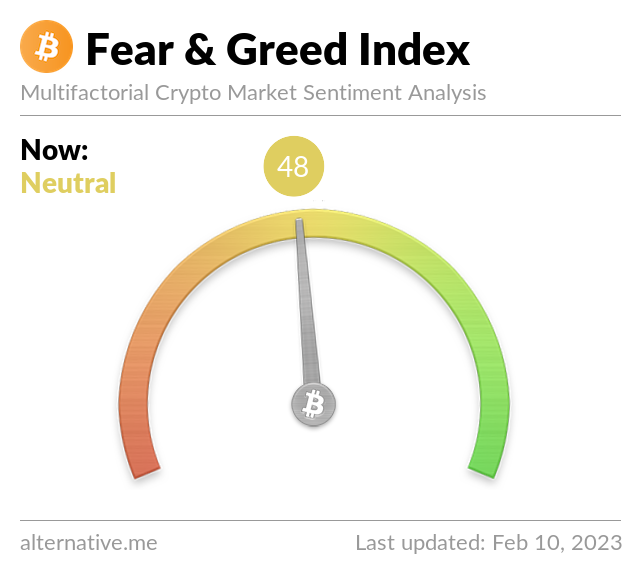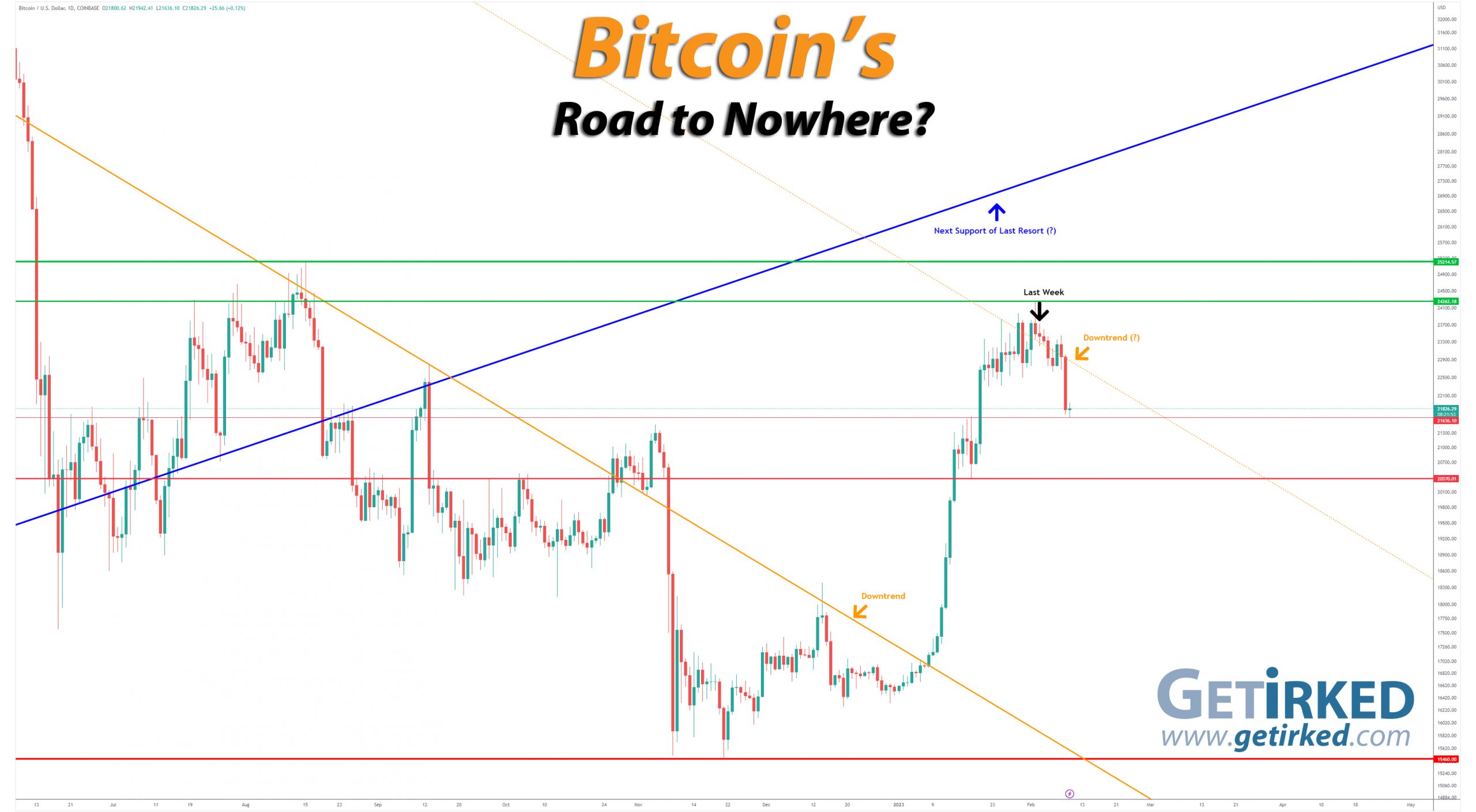Summing Up The Week
“The stock market will humble us all, just not all at the same time.”
I’ve seen this quote posted many times on Twitter by analysts I respect, and it is very true. Right now, the stock market’s moves are confounding to many, since macroeconomic and geopolitical concerns would traditionally indicate bearish moves, while the stock market continues to rally.
In fact, only one analyst I follow, Michael Gayed, CFA, predicted this “melt-up” based on the many economic conditions he observes. What should be more concerning is what he sees coming next based on this tweet from Tuesday:
Every single bear narrative has been destroyed.
Melt-up.
Then, just as everyone believes the bear market is over, comes the credit event.
That’s right. Gayed sees a “credit event” this year. While the term may seem innocuous, prior “credit events” include the debt ceiling crisis in 2011 where the S&P 500 sold off more than 20% in a few weeks, and, of course, the Great Financial Crisis in 2008-2009 where the S&P 500 dropped more than -60% from its highs.
To make matters worse, we have a debt ceiling crisis coming due in June, and, seasonally, June is a bearish month in a typical year. If the Democrats and Republicans can’t reconcile the debt ceiling issue prior to June – and there is no historical precedent indicating they will – this summer could be exciting for the bears and terrifying for bulls.
Nothing to worry about for the next few months, but I felt it worthwhile to put this on your radar. If you’d like to follow Gayed, his preferred method is Instagram (@leadlagreport) but he also regularly posts to Twitter (@leadlagreport).
With that, lets move on to the news that moved the markets this week…
Market News
Powell sees inflation easing, but rates will still rise
In a speech Federal Reserve Chairman Jerome Powell gave to the Economic Club on Tuesday, Powell said inflation is easing but interest rates are still likely to rise, reported CNBC.
“The disinflationary process, the process of getting inflation down, has begun and it’s begun in the goods sector, which is about a quarter of our economy,” said Powell. “But it has a long way to go. These are the very early stages.”
Powell went on to say that the Fed expects to see inflation to continue to decline. “We expect 2023 to be a year of significant declines in inflation. It’s actually our job to make sure that that’s the case,” he said. “My guess is it will take certainly into not just this year, but next year to get down close to 2%.”
The markets rallied following Powell’s speech with investors and traders interpreting the decline in inflation as bringing lower interest rates by the end of 2023 (regardless of whether or not this will actually be the case).
China’s spy balloon may cause escalation of tensions
While comedy skit shows like Saturday Night Live poked fun at the spy balloon China sent over the entirety of the United States last week, experts warn that this pattern of behavior poses a threat to NATO members, reported CNBC.
Even though the U.S. shot down the balloon, whose payload was equivalent to an entire passenger airliner, over the Atlantic Ocean in defense of national airspace, the Chinese government promised “retaliation for an obvious overreaction.” When we’re talking about a communist dictatorship, that retaliation could mean a potential attack on Taiwan, or ousting of American companies with substantial interests in China including Apple (AAPL), Nike (NKE), and Starbucks (SBUX).
Combine the potential outcomes with the fact that there is no escalation agreement between China and the U.S. like there was during the Cold War between Russia and the U.S. in the 1950s-1980s, and there repercussions for an escalation in tensions could be, quite literally, apocalyptic.
However, despite many analysts and pundits pointing out these concerns, the market brushed off Chinese rhetoric this week as stocks continue to melt up.
Google’s BardAI gets an ‘F’ in its first outing
Following the launch of ChatGPT and Microsoft’s (MSFT) multi-billion dollar investment in OpenAI, the company behind the AI system, Alphabet (GOOGL) rushed to launch BardAI, its own artificial intelligence platform, which flopped, producing false answers to basic questions and causing the company’s stock to drop $100 billion, reported NPR.
The question… err… in question involved facts about space, in which BardAI erroneously stated that the James Webb telescope was the first to take pictures of exoplanets in 2022, when, in reality, that feat took place 18 years earlier when the Very Large Telescope (VLT) took a photo of exoplanet 2M1207b.
Pundits on Twitter expressed confusion how a not-yet-commercial product’s simple failure could cause Alphabet’s stock to drop more than five times the value of OpenAI. Obviously, these pundits are stock analysts and not technology professionals.
As someone who has been deep in the tech space for more than 40 years, allow me to explain. The reason for Alphabet’s huge devaluation isn’t directly connected to the perceived value of its competitor – it’s the fact that Alphabet used to be the disruptor and it has now become the disrupted.
- When Google launched in the early 2000s, Yahoo disregarded the new upstart as an also-ran search engine. When was the last time you “Yahoo’ed” anything?
- In 2008, Microsoft’s (MSFT) then-CEO Steve Balmer famously proclaimed that Apple’s (AAPL) iPhone would never amount to anything.
- In 2018, Intel (INTC) ignored Advanced Micro Devices’ (AMD) new processors, believing that AMD could no longer compete in CPUs.
Yahoo is no longer publicly traded, Microsoft shut down its complete failure Windows Phone, and Intel’s stock is down -40% since January 2018 whereas AMD’s is up +685% over the same time period.
In all of these cases, the then-leader in the space was completely overthrown by the new company – the disruptor. Alphabet has become complacent just like Yahoo, Microsoft, and Intel, claiming that it had been spending millions on artificial intelligence development for years, and, when it came to launching its own, the AI failed at answering basic encyclopedic questions.
What good is your artificial intelligence if it isn’t, well, intelligent?
Unless Alphabet can get its act together, it could potentially go the way of Yahoo (no longer public) or Intel (down more than -40% since January 2018 versus AMD which is up +685% over the same time span).
Next Week’s Gameplan
A lot of people act like they know which way the market is going to head next and more than half of them will be wrong. The challenge is knowing which half.
As investors, we must remember our role is not to predict which way the market is going to go. Stop trying to be right.
Since the market can only move two directions – higher or lower – the answer is shockingly simple: make a plan for both directions. What are you going to do if your stocks head higher and what are you going to do if your stocks head lower?
If you stop trying to be right, you can never be wrong.
I’ll see you all back here next Friday!
This Week in Play
Stay tuned for this week’s episodes of my two portfolios Investments in Play and Speculation in Play coming online later this weekend!
Crytpo Corner
Important Disclaimer
Get Irked contributors are not professional advisers. Discussions of positions should not be taken as recommendations to buy or sell. All investments carry risk and all readers must accept their own risks. Get Irked recommends anyone interested in investing or trading any asset class consult with a professional investment adviser to determine if an investment idea is suitable to them and their investment goals.
Bitcoin Price (in USD)
%
Weekly Change
Bitcoin Price Action
The Bitcoin Pullback has started!
After consolidating for the past two weeks, Bitcoin started to see weakness when dealing with the new Downtrend (?) line this week, breaking below last week’s weekly low at $22,500.00 on Thursday before finding support at $21,636.10 on Friday.
If that support breaks, the next key level support is quite a bit lower at $20,370.01. And, if Bitcoin can’t hold $20K, the downside could be substantial.
The Bullish Case
Despite the break of support, Bulls stand firm, claiming that the current selloff is a routine pullback before Bitcoin finds support and heads to new all-time highs. Bullish pundits continue to tout this year’s rally as the start of the next bull market.
The Bearish Case
More aggressive Bears are already doing victory dances, however, it’s far too early to get that excited. The Bulls have a valid point: after a rally as substantial as what we’ve seen just since the beginning of 2023, a pullback was inevitable. The big question will be: where will Bitcoin bottom?
Bitcoin Trade Update
Current Allocation: 2.579% (-2.687% since last update)
Current Per-Coin Price: $21,368.31 (-2.405% since last update)
Current Profit/Loss Status: +2.143% (-6.075% since last update)
Once Bitcoin started to demonstrate weakness during its price consolidation this week, my discipline dictates that I have to keep reducing my allocation.
Whereas in stocks, price consolidation is considered bullish as buyers rest before starting the next bull run, price consolidation in crypto often indicates a loss of momentum. When momentum is lost in crypto, the corrections (selloffs) are beyond severe. Accordingly, reducing size is the most prudent course of action.
I made several sales this week which left me with an average selling price of $22,516.28 (after fees). The sales lowered my per-coin cost -2.405% from $21,894.77 to $21,368.31, and, more importantly, reduced my allocation -2.687% from 5.266% to 2.579%.
Obviously, I remain bearish. I believe if we see Bitcoin lose support around $20K, the pullback could be significant. Not only is it possible that Bitcoin could test its current cycle low around $15,500, if the bears are to be believed, lower lows could be in store.
That being said, now that I have freed up so much of the allocation, I am adjusting my quantities to add more than I had been in prior weeks so I can build up an amount I’d be comfortable owning if Bitcoin tested its 2022 lows and did not go lower from there.
Bitcoin Buying Targets
Using Moving Averages and supporting trend-lines as guides, here is my plan for my next ten (10) buying quantities and prices:
0.041% @ $20,024
0.057% @ $19,831
0.199% @ $18,941
0.284% @ $17,574
0.426% @ $16,974
0.426% @ $16,705
4.257% @ $15,580 <– 2022 low
0.568% @ $15,208
0.710% @ $14,262
0.851% @ $13,759
Not Your Keys, Not Your Crypto…
In light of everything happening with brokerages, I no longer keep any of my crypto on an exchange and I only keep enough USD on the exchange to execute my next few buys. I use multiple cold wallets from the brands Ledger and Trezor to hold my crypto (click the links to access the direct sites, and I receive no affiliate benefits from these links).
Additionally, I have now divided my allocated USD between two different exchanges – Gemini and Coinbase – in case one (or both) becomes insolvent. Disclaimer: We both receive a bonus if you use either my Gemini or Coinbase referral links to open accounts.
Given everything that happened with FTX and Sam Bankman-Fried claiming customer funds were safe only to have it go completely bankrupt, I do not trust anyone in the space, even with Coinbase (COIN) being publicly traded (and one of my own Investments in Play positions).
No price target is unrealistic in the cryptocurrency space – Bullish or Bearish.
While traditional stock market investors and traders may think the price targets in the cryptocurrency space are outlandish due to the incredible spread (possible moves include drops of -90% or more and gains of +1000% or more), Bitcoin has demonstrated that, more than any speculative asset, its price is capable of doing anything.
Here are some of Bitcoin’s price movements over the past couple of years:
- In 2017, Bitcoin rose +2,707% from its January low of $734.64 to make an all-time high of $19,891.99 in December.
- Then, Bitcoin crashed nearly -85% from its high to a December 2018 low of $3128.89.
- In the first half of 2019, Bitcoin rallied +343% to $13,868.44.
- In December 2019, Bitcoin crashed -54% to a low of $6430.00 in December 2019.
- In February 2020, Bitcoin rallied +64% to $10,522.51.
- In March 2020, Bitcoin crashed nearly -63% to a low of $3858.00, mostly in 24 hours.
- Then, Bitcoin rallied +988% to a new all-time high of $41,986.37 in January 2021.
- Later in January, Bitcoin dropped -32% to a low of $28,732.00.
- In February 2021, Bitcoin rallied +103% to a new all-time high of $58,367.00.
- Later in February, Bitcoin dropped -26% to a low of $43,016.00.
- In April 2021, Bitcoin rallied +51% to a new all-time high of $64,896.75.
- In June 2021, Bitcoin crashed -56% to a low of $28,800.00.
- In November 2021, Bitcoin rallied +140% to a new all-time high of $69,000.00.
- In November 2022, Bitcoin crashed -78% to a low of $15,460.00.
Where will Bitcoin go from here? Truly, anything is possible…
What if Bitcoin’s headed to zero?
The only reason I speculate in the cryptocurrency space is I truly believe Bitcoin isn’t headed to zero. I am prepared for that possibility, however, by knowing I could potentially lose all of the capital I’ve allocated to this speculative investment. Professional advisers recommend speculating with no more than 5% of an investor’s overall assets. Personally, I’ve allocated less than that to speculating in crypto. I feel that anyone who doesn’t fully believe in the long-term viability of cryptocurrency would be better served not speculating in the space. On a good day, this asset class isn’t suitable for those with weak stomachs. On volatile days, the sector can induce nausea in the most iron-willed speculator. If a speculator isn’t confident in the space, the moves will cause mistakes to be made.DISCLAIMER: Anyone considering speculating in the crypto sector should only do so with funds they are prepared to lose completely. All interested individuals should consult a professional financial adviser to see if speculation is right for them. No Get Irked contributor is a financial professional of any kind.


